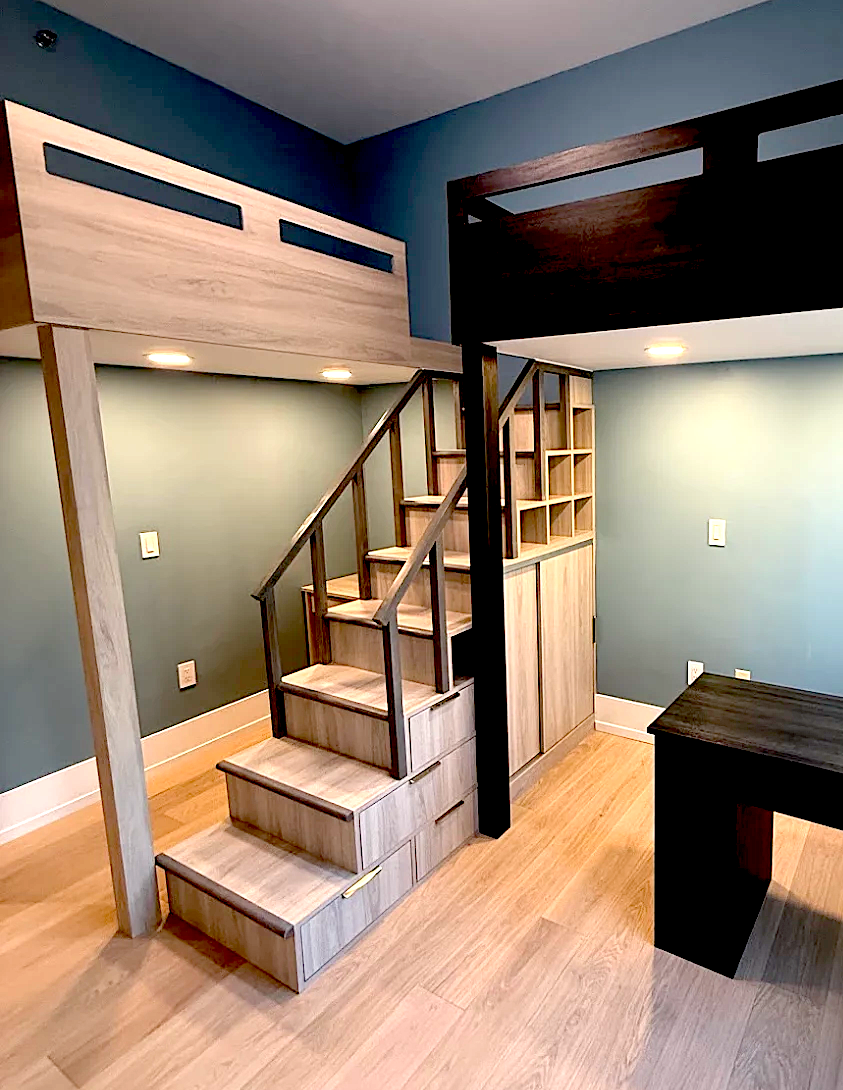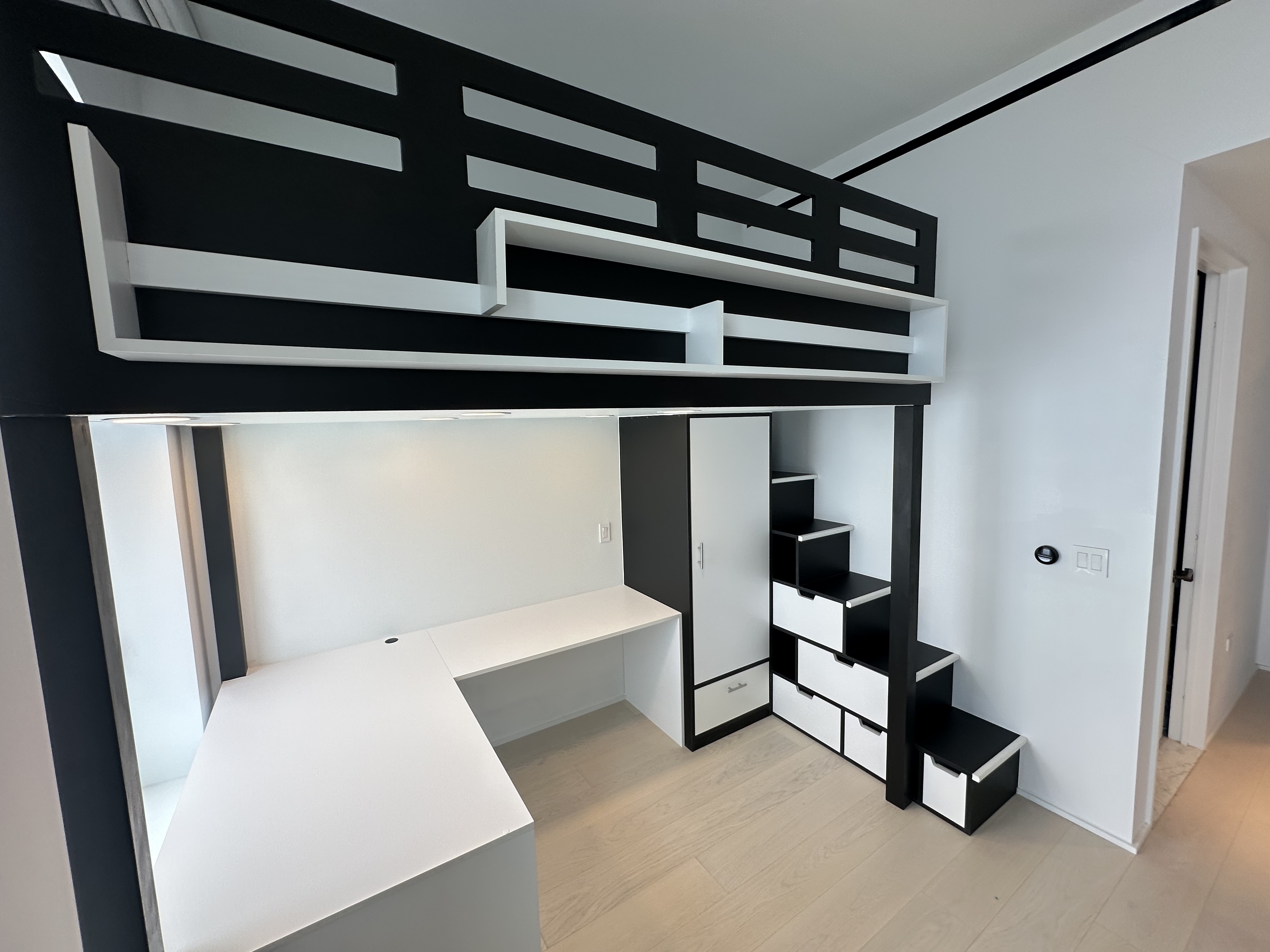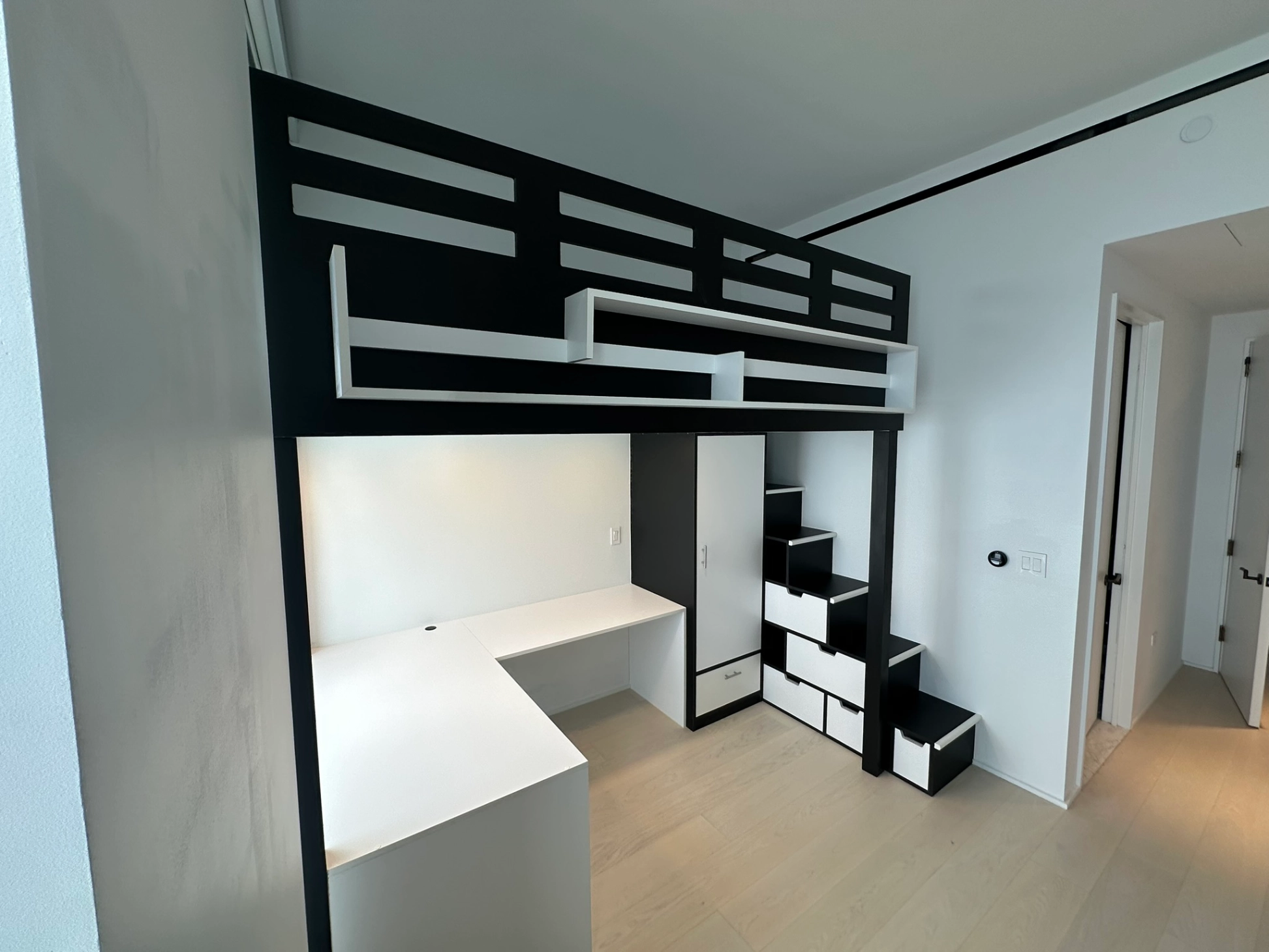A bunk bed stacks two or more beds in one frame to save floor space when two people share a room, while a loft bed raises a single bed and leaves the area underneath open for a desk, storage, or seating. If you need multiple sleeping spots, go with a bunk bed. If you want one bed and more usable space, choose a loft bed. Both styles make smart use of vertical space, but a custom-built loft bed can be tailored to your room’s layout, giving you better stability, design flexibility, and long-term use.
If you have a small bedroom or apartment, it is natural to look at the vertical space and think, “Let’s get the bed off the floor.” That is when people start searching for bunk beds and loft beds, and then get confused because the words get used like they mean the same thing.
They do not.
Bunk beds and loft beds solve different problems, and picking the wrong one can waste space or make the room harder to use.
This guide breaks down the difference in simple terms, shows when each one makes sense, and walks through real layout examples, including small New York City rooms. You will also see where a custom built-in loft beats a flat-pack bunk bed.
Quick Answer: Bunk Bed vs Loft Bed
If you just want the short version:
- Bunk bed = two or more beds stacked into one frame. Best when you need more than one sleeping spot in the same room.
- Loft bed = one raised bed with open space under it. Best when you need one bed plus extra space for work, storage, or living.
Here is a simple way to think about it:
- One sleeper, tiny room, need a desk or sofa too → Loft bed.
- Two kids sharing, not much floor space → Bunk bed.
- Adult studio apartment, want a proper workstation or lounge under the bed → Loft bed, ideally custom built.
The rest of the article goes into detail so you do not guess.
What Is a Bunk Bed?
A bunk bed is one unit with at least two beds stacked vertically. The top bed sits above the bottom one, with a ladder or stairs to reach the upper level.
Typical features:
- Two mattresses in one frame
- A ladder or small staircase
- Guardrails on the top bed
- Often twin over twin, twin over full, or full over full
When a Bunk Bed Makes Sense
A bunk bed is usually the better choice if:
- You have two or more kids sharing one room
- You get a lot of sleepovers or guests
- You want to use one wall for both beds and leave the rest of the room open
In those cases, a bunk bed gives you more sleeping space without doubling the footprint.
Pros of Bunk Beds
- Two beds, one footprint
- Good for siblings or roommates
- Can feel fun and cozy for kids
- Some models split into two separate beds later
- Some have trundles or drawers underneath
Cons of Bunk Beds
- The lower bed still uses floor space
- Harder to sit up in the bottom bunk if the ceiling is low
- Making the top bed can be a pain
- Climbing at night can be awkward for younger kids or half-asleep adults
- Many flat-pack frames move or creak over time if not installed well
What Is a Loft Bed?
A loft bed is a raised bed with open space underneath instead of another mattress. The bed platform is supported on legs or a built-in frame, with a ladder or stairs to reach the top.
Underneath, you can fit:
- A desk or workstation
- A sofa or lounge area
- Storage cabinets and wardrobes
- A play area for kids
- A mix of the above
When a Loft Bed Makes Sense
A loft bed is usually the better choice if:
- You only need one bed in the room
- You want more usable floor space for work or relaxing
- You are working with an awkward room shape but decent ceiling height
- You live in a studio and want to separate “sleep” from “everything else”
Pros of Loft Beds
- Frees up full floor space under the bed
- Works for kids, teens, and adults when built properly
- Lets you create a home office, studio, or reading corner in a tiny room
- Easier to walk around the room compared to two separate beds
- With a custom build, you can match storage, desk, and stairs to the exact wall
Cons of Loft Beds
- Only one sleeping spot per frame
- You still have to climb to bed every night
- Cheap loft frames can feel wobbly if not braced well
- If the ceiling is low, it can feel cramped near the top
Key Questions To Ask Before You Choose
Before you click “buy” on anything, answer these questions honestly:
- How many people need to sleep in this room on a regular week?
- If the answer is “two every night”, a bunk bed may make more sense.
- What is the ceiling height?
- Measure floor to ceiling. Now subtract the mattress thickness and about 30 inches for comfortable sitting. If your head will scrape the ceiling, the bed is too high.
- What is the floor plan really like?
- Doors, windows, radiators, closets, oddly placed pipes.
- A flat-pack bunk does not care. A custom loft can be cut around them.
- Do you need a real workspace or just extra storage?
- If you want a full desk, consider a loft with a built-in work area.
- If you just need storage, both bunks and lofts can be built with drawers, shelves, or wardrobes.
- Who will be climbing the ladder?
- Small kids? Teens? Adults coming home late from work?
- That affects ladder angle, step size, and whether you go for stairs instead.
Safety Basics For Bunk And Loft Beds
No matter which way you go, safety is not optional. A few non-negotiables:
- Guardrails
The top bed must have guardrails on all open sides, with gaps small enough that a child cannot slip through. - Correct mattress height
The mattress should not sit so high that it cancels out the guardrail. Most frames specify a maximum mattress depth. Follow it. - Sturdy ladder or stairs
- Steps should be wide and not too steep.
- The ladder must be fixed firmly, not floating loose.
- For younger kids, many parents prefer stairs with built-in drawers.
- Solid attachment
For built-in lofts, the frame should be properly anchored to walls and, often, the floor. This is where a local carpenter who understands real loads and fixings matters. - Room layout
Leave headroom above the bed and clear space at the ladder. Do not cram the top bunk right under a ceiling fan or low light.
At LoftBedsNYC, we also look at the age, weight, and habits of the people using the bed. A loft built for a 6-year-old and a loft built for two adults pulling long shifts in the city should not be treated the same.
Bunk Bed vs Loft Bed In A Small NYC Apartment
Let’s bring this into real life. New York rooms are not exactly generous.
Scenario 1: Two kids, one narrow bedroom
- You have a long, skinny room with one decent wall.
- Both kids sleep there every night.
Better choice:
A bunk bed or even a custom bunk-plus-storage build along one wall. The goal is to give each child their own bed while leaving enough space for play and maybe a shared desk on the opposite wall.
Scenario 2: Adult studio, need bed + workspace
- You live in a studio with one main room.
- You work from home some days.
Better choice:
A loft bed with a built-in desk and storage underneath. Sleeping up high keeps the “bedroom” out of your main living zone, and you get a full workstation where a regular bed would sit.
Scenario 3: One bedroom, regular guests
- You have one small bedroom and guests a few times a month.
Options:
- A loft bed for yourself with a sofa bed underneath for guests.
- Or a bunk bed if you are okay with a more “shared” setup and do not need workspace.
The point is simple. In tight city rooms you are not choosing between “fun for kids” and “adult furniture”. You are deciding how that room has to work every day. That is where lofts normally win.
Flat-Pack Bunk vs Custom Built-In Loft
Most of the sites ranking right now are selling flat-pack beds. LoftBedsNYC is different. We build custom, built-in loft structures that are made for New York rooms, not for a warehouse shelf.
Here is how that changes things.
Space Use
- Flat-pack frames come in fixed sizes. You lose inches on each side.
- A built-in loft can run wall-to-wall, even around pipes or soffits, so you use every inch of space.
Stability
- Flat-pack beds rely on bolts and light frames. They are fine at first but can loosen over time.
- A custom loft is framed and braced like a piece of real carpentry, then anchored into the structure of the building.
Design And Storage
- Off-the-shelf beds give you a couple of storage options.
- With a custom loft, stairs can become drawers, side panels can hide closets, and the underside can be a full office, studio or lounge, not just “some space.”
Long-Term Use
- Kids grow. Adults change jobs. People move furniture around.
- A well designed loft can be re-painted and reconfigured without being thrown away. The structure stays, the details change.
If you are in a rental, we can still design with that in mind, so removal later is clean and the walls are respected.
How LoftBedsNYC Helps You Decide
If you are still stuck between a bunk and a loft, you are not alone. That is why we start every project with a real conversation and a tape measure, not just a product catalogue.
Here is how we usually work:
- Listen and measure
- How many people need to sleep here?
- How tall are they?
- What else has to live in this room? Desk, music gear, bike, books, dog bed?
- Check the room properly
- Ceiling height, windows, radiators, baseboard heaters, outlets, pipes.
- We look for problems before they become problems.
- Propose a layout
- Sometimes that is a bunk solution.
- Often it is a loft with integrated wardrobe, desk, or seating.
- We sketch where the ladder or stairs should go so the room still flows.
- Build it like real furniture, not a toy
- Solid framing, secure fixings, correct guardrail and mattress heights.
- Finishes and details that match the rest of your home, not a random catalog style.
That is the difference between “buying a bed” and actually solving a space problem.
FAQ: Bunk Beds vs Loft Beds
Are loft beds only for kids?
No. Properly designed loft beds work for teens and adults too. The key is strong framing, enough headroom, a sensible ladder or stairs, and a mattress that suits adult weight and sleep habits.
Are bunk beds safer than loft beds?
Neither one is automatically safer. Safety comes from:
- Solid build quality
- Correct guardrails and mattress height
- A secure ladder or stairs
- Good installation
A badly built bunk is less safe than a solid loft, and the other way around.
Can I turn a bunk bed into a loft bed later?
Some systems are modular, so the lower bed can be removed and the top can become a loft. Others cannot. If you think your needs will change, discuss future layouts before you buy or build.
What if my ceiling is low?
You may still be able to use a low loft or a low bunk. We often design for tight spaces by lowering the platform height, choosing a thinner mattress, and adjusting the ladder or stairs so it still feels comfortable and safe.
If you are in New York City and trying to decide between a bunk bed and a loft bed, you do not have to guess. Bring us your room measurements, a couple of photos, and who is sleeping there. We will help you work out what actually fits your space and your life, then build it to last.




